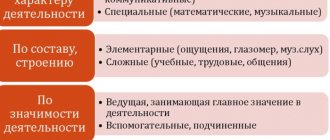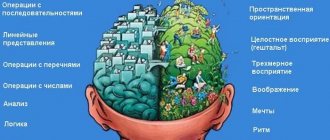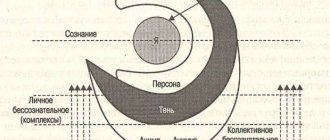People deal with two types of information every day: non-verbal, that is, numbers or images , and verbal - text.
Employers evaluate information processing skills not out of curiosity. Research shows that nonverbal tests reliably predict job performance
employee at the interview stage, which saves the company’s resources, increasing its profits. These observations are confirmed by international experience.
Is there a nonverbal logic test coming soon?
Get ready
About testing
If text analysis exercises assess indicators of verbal logical thinking, then non-verbal exercises assess visually effective and imaginative thinking. Skills related to the analysis of abstract information also indicate the level of intellectual abilities of the candidate.
Ubiquitous intelligence tasks consist of verbal and nonverbal tasks, for example, the Wechsler, Cattell, and CAT tests.
Verbal, non-verbal intelligence tests, and situational testing are used not only for employment, but also at various personnel competitions. For example, on “Leaders of Russia”. It has been using tests from SHL for several years in a row.
How can you develop the nonverbal component of intelligence?
Nonverbal intelligence can be developed. Today, there are special techniques and exercises for this, the systematic implementation of which will help develop this substructure of intelligence.
First of all, a person seeking to develop the non-verbal structure of intelligence must learn not just to look, but to see. For example, when you see cars colliding on the road, you should not limit yourself to a superficial inspection of the situation. Attempts to see the full picture and understand the causes of the incident contribute to the development of the nonverbal component. By restoring all the factors that have fallen out of sight and the holistic picture of the situation, a person trains his intellect and develops the level of observation.
Breaking thought patterns is an equally progressive technique. At the initial stage, you can change such simple things as the route from home to work or the path taken around the store while shopping. Any change in habitual actions and pictures prompts the brain to change the picture of the environment, which becomes familiar and pulls the person into the comfort zone.
The development of the nonverbal substructure of intelligence is facilitated by reading difficult-to-perceive literature and understanding each step described in this literature. No less useful is thoughtful reading of literature concerning activities unusual for humans.
What do tasks look like?
Most often, nonverbal testing takes place remotely.
HR sends a link to testing by email. The passing score is determined depending on the results of the control group or the results of other candidates. If a person manages to pass, he is invited to an in-person interview. Sometimes testing takes place in person, in the presence of an examiner, on a computer or on paper. The procedure and rules of procedure depend on company policy. It is recommended to check with HR for details in advance. The developer will be recognized from him.
Tasks are of the following types:
- numeric;
- brain teaser;
- tests for mechanical understanding;
- combined, to determine the level of intelligence.
brain teaser
Nonverbal logic test (online):
Go throughGet ready
Logic tests used in hiring are the heirs of psychological IQ tests. Task developers, for example, SHL or TalentQ, adapt classic tasks taking into account the vacancy, company and new selection methods.
Testing to determine logical abilities also allows you to evaluate a candidate’s learning ability, mental acuity and problem-solving skills.
Most often, problems are caused by non-verbal logic - tests with answers to such problems will not help with preparation. To practice, you need advanced guides: they collect typical problems and give tips on how to solve them.
The test consists of 15-20 questions. The answer options are presented in graphical form. A typical question is: continue a graphical or numerical sequence.
To understand mechanics
Nonverbal Mechanical Intelligence Test:
Go throughGet ready
Mechanical understanding testing is used for technical and engineering positions and for those who repair or diagnose machinery.
It allows you to assess the candidate’s logical thinking and assess how much he understands how “the world around him works.”
Workers in production and engineering professions daily encounter mechanisms and the application of physical laws, so they must understand what consequences certain actions or decisions will lead to.
Sometimes similar testing is used for “office positions”, as an addition to intelligence tasks. Thus, the employer evaluates the general level of knowledge, education, learning ability and even motivation of the person.
The test consists of 15-20 questions with illustrations and several answer options.
Numerical
Nonverbal (numerical) ability test:
Go throughGet ready
The basis of distance testing is numerical tests. They are used in selection for vacancies related to calculations (both technical and financial) and analysis of numerical information. It is not enough for a candidate to complete a sequence of mathematical operations. You need to analyze the data, interpret it and draw the right conclusions.
Typically, a typical task is:
- table, graph or combination thereof;
- question;
- answer options.
Comment:
You won’t have to remember any formulas or theorems. Determine what the area of a triangle is, too.
When solving, only basic mathematical operations are used:
- Multiplication, division, addition, subtraction;
- Proportions;
- Percentages, shares.
The main feature and difficulty is the need to quickly analyze a large amount of graphic and numerical information in a short period of time. The solution itself will take no more than 10-15 seconds.
Scythe Cubes
The original test was developed by Oregon State psychology professor S. C. Kos in 1927 under the name "The Block Design Tests." The Kos Cubes test became most widely known after it was included in 1939 by American psychologist David Wexler in a battery of subtests to measure intelligence. Wexler simplified the original version of the test, reducing the number of cubes to nine, colors to two, and pattern cards to ten. To date, this modification of the test has been successfully used in D. Wechsler’s methodology for measuring intelligence. The “Kosa Cubes” test, due to the complex nature of the tasks, turned out to be the most informative in the study of non-verbal intelligence in general and began to be considered as an independent means for measuring it. The functioning of nonverbal intelligence is associated with the characteristics of perception, motor skills, visual-motor coordination, the specifics of spatial representations, constructive and heuristic abilities. “Kos Cubes,” which require the manifestation of a complex of the listed qualities, turned out to be highly sensitive to identifying non-verbal talent. The test is widely used in career guidance and selection to assess abilities for manual practical activities and intellectual prerequisites for technical abilities, in education to identify intellectual learning capabilities, in medicine to diagnose a number of neuropsychological and psychopathological symptoms.
During the testing process, the subject is asked to assemble the figure shown on the card from the available cubes. The time to work on each figure is limited. Observing the behavior of the subject during testing also allows us to obtain additional information about the qualitative uniqueness of his thought processes, the characteristics of his emotional response and character traits, and some psychopathological symptoms. The test has child and adult forms and allows you to work with people aged 5 to 75 years, adapted on a domestic sample.
Developers of nonverbal tests
The times when employers used questions from the field of clinical psychology in their practice are gone. Today, similar tasks are developed by consulting and recruitment agencies. Both psychologists and personnel consultants, HR, engineers and assessment specialists participate in their creation.
For each company that has ordered the creation of testing or the implementation of a comprehensive selection system, tasks are developed in accordance with the requirements of the vacancy or profession.
Most often, employers use tests from:
- SHL;
- TalentQ;
- OnTarget;
- Saville consulting.
Advantages
- The Nonverbal Ability Test reliably assesses candidates regardless of language skills, cultural or racial differences. It is important for employers to understand whether the candidate will be able to cope with the assigned tasks and benefit the company.
- The developed assessment matrices allow assessment tests to be carried out by people without psychological education.
- Instant results.
- Minimal sensitivity to the candidate's mood swings.
Flaws
- Cost of creation and implementation.
- Additional difficulties for applicants
Rapport and rapport building
Rapport in psychology and NLP is a special state between people when connection, mutual understanding, and trust are felt at the internal level; specific contact and the state itself when people are in this contact.
Simply put, rapport is identity with another person, similarity to him. Establishing rapport can be done by adjusting to categories according to Satir, joining, mirroring, as well as perception from the second position.
Establishing rapport
Establishing rapport is a fundamental goal in NLP. It can happen over a long period of time or very quickly. The duration of the process itself often depends on the level of the communicator. And rapport can be achieved on two levels: conscious and unconscious.
The sensory acuity of the communicator is also very important in establishing rapport, i.e. his ability to most effectively notice and track the nonverbal manifestations of another person, the external features of his behavior. People always send various signals that reflect their internal processes, and the development of sensory acuity makes it possible to “read” them, as well as determine the effectiveness or ineffectiveness of attunement with another person and the presence or absence of rapport with him.
The development of sensory acuity is a serious process, but very interesting. And its constant training will allow you to learn to track such features of people’s communication that were not previously noticed. And in order for this to become possible, you need to follow several effective recommendations:
- During communication, try to “break down” this process itself into separate components and track them.
- Monitor each person's nonverbal characteristics and reactions.
- Observe people carefully and listen to what they say.
- Watch strangers: at work, in public places, in movies and TV shows.
- Pay attention to the “little things”: breathing, rate of speech, complexion, shape of lips, tone and timbre of voice.
By improving your sensory acuity skills, you will also improve your rapport-building skills, and you will also become more deeply aware of other people and their behavior, learn to predict future interactions, recognize lies and truth, and learn to convey your own messages in a way that evokes only the reactions you need.
And the last question that we will examine in this lesson is the Milton Erickson model or, more simply, the Milton model. But, given that this topic is very voluminous and requires in-depth study, the following section of the article would be more correctly described as an introduction to the Milton model.
Control
When taking a test online, applicants are tempted to cheat: find nonverbal tests with answers on the Internet, or ask friends for help. The developers have provided for this.
The most effective way to combat dishonest approaches is considered to be a retest: after the candidate successfully passes the remote part, he is invited to an in-person interview.
On it, in the presence of the examiner, he is asked the same questions, but in random order. If it turns out that while taking the test from home, he scored 75%, and in the presence of the examiner 25%, he will be disqualified.
In addition to retesting, to control validity they use:
- Audio and video recording;
- Desktop recording;
- Control of running processes and open browser tabs.
Features of nonverbal communication
Nonverbal communication is a situational reflection of people’s personal characteristics: mood, emotional background, attitude towards others and the topic. This communication is involuntary and spontaneous, it is difficult to divide it into individual elements (postures, facial expressions, olfactonics), this is the key feature of nonverbalism. Gestures, intonation, gaze are difficult to study or edit; it will take years and decades. But even trained people can be caught lying when one part of communication does not match another. Sign language is trusted more; it is perceived at the level of intuition.
Open posture in negotiations
Nonverbalism is an important element of communication, carrying 60-80% of information with the body, only 20-40% of communication is realized in words. It is worth closing your eyes and hiding your hands if you need to hide insincerity - this was the conclusion of one observant English court official.
Feasibility
Psychometric tests have long been recognized by the international community as a valid way to predict employee productivity. And while the benefits for employers are obvious, job seekers do not always know how to use the results to their advantage.
For an employee, test results are, first of all, indicators of his professional growth. This is a clear result of his progressive work, which is used as an argument when talking about promotion.
For the applicant, this is an opportunity to stand out from the crowd and personally influence the hiring decision. Whether the employer will like the resume or not is a factor that the candidate cannot influence. And he has the power to influence his preparation and his results. Such a person will outperform his competitors, even if they have more experience or recommendations.
The history of the emergence of nonverbal means of communication
Nonverbal behavior as a set of gestural and figurative expressions through the body arose at the dawn of humanity, when language as a means of communication had not yet been invented, and communication between individual representatives of the tribe was carried out precisely through nonverbal behavior.
It was possible to convey information through primitive gestures, and non-verbal means of communication coped with the task that ancient people needed to solve perfectly. They pointed to prey and fellow tribesmen with their hands, depicted simple phenomena - rain, thunderstorms, mimicked anger, threatened, grinning and baring their teeth.
An excellent example of primitive nonverbal behavior is the communication of dogs. Dogs almost never bark when meeting - they communicate by changing their gait, posture, level of tail movement, grinning or lowering their ears, and the information they receive is enough for them to correctly assess the situation and the status of their interlocutor.
If you fail
Since the purpose of the online stage is to weed out insufficiently qualified candidates, if you fail it, there will be almost no chance of getting a job. If the company uses a full-fledged applicant assessment system, the initial selection is carried out by HR employees. They rate work experience and technical skills nominally. Until the candidate passes this stage, he will not get an interview with the technical director. Therefore, you should not expect that a negative assessment on testing will be compensated by experience or recommendations.
What is verbal ability?
Well-developed verbal abilities allow a person to master the language system. It includes various elements and rules for using and connecting these elements. The language system includes:
- phonetic side of speech;
- grammatical structure of speech;
- lexical side of speech;
- syntax.
The phonetic side of speech is the sound composition of the language. Verbal abilities allow you to distinguish sounds by ear and determine the correctness of your pronunciation. In grammar, verbal abilities are manifested by correctly constructed utterances, the words in which are consistent, cases and prepositions are used correctly. In syntax - beautifully and correctly formed sentences that make up a coherent text. The vocabulary of a person with well-developed verbal abilities is usually rich.
All of the above helps in the verbal side of communication, that is, communication that occurs using speech. Highly developed verbal thinking helps to convey your thoughts to your interlocutor, convince you that you are right, and establish dialogue and joint activities. With insufficient development of these abilities, the communication process is difficult (see Dysarthria in children). Only the non-verbal side of communication (facial expressions, pantomime and gestures) does not provide sufficient information. High-quality use of speech to convey information is necessary in the communication process.
How to prepare
Since unique tasks are developed for each company, there is no point in trying to learn the answers. Preparation for nonverbal reasoning tests comes down to two components:
- Solve practice nonverbal tests online.
- Studying guidelines and manuals.
The main problem with nonverbal communication tests is the time allocated for each task. As a rule, this is no more than 1 minute.
During this time, you will have to navigate the conditions, understand the issue, choose a strategy and begin to solve it. This time is not enough for an unprepared person. Although the tasks are not repeated, they are created according to the same principles.
By solving training tasks, the candidate not only improves his reaction speed and learns to quickly navigate questions, but also becomes familiar with typical problems.
For most tasks, methodological instructions and free guides for solving them have been created, which provide advice on how to properly organize time and show decent results. They also cover typical questions with example solutions and comments.
The second factor influencing success is preparation time. Since preparing for tests involves developing skills, it takes time to consolidate them. There is no point in preparing the day before testing - this requires at least a week.
BEZMOLIT.TV – Life by your own rules
Since this article is about the non-verbalizable, and the author has to balance on the brink of what is expressible with the help of words, the reader is inevitably faced with the problem of misunderstanding. However, this state of affairs has already become traditional for the series of my “academic” articles. You must be prepared for the “opacity” of the text and make some efforts to interpret the terms used - to find their analogues in your own picture of the world.
In particular, I want to warn you in advance regarding the concepts “Language” and “Thinking” - in this article their use is noticeably different from the dictionary. Such a redefinition leaves at least a ghostly chance of conveying the author's thoughts.
Does nonverbal thinking exist? It would seem that the answer to this question is self-evident.
It is as self-evident as the answer to the question “does a chess player think during a game?” Of course he does. And of course - non-verbally. Grandmasters do not conduct an internal dialogue with themselves like “now I will move this knight to f2, and then...” - otherwise, under time pressure, they would constantly lose to opponents with a more effective thinking strategy.
Moreover, a similar conclusion can be reached by analyzing the actions of the carpenter Uncle Vasya, who can put together a table (which in general should presuppose thinking), but is not able to describe exactly how he does it. However, there are some “experts” who continue to defend the thesis of obligatory verbality, getting out of this difficult situation by asserting that what Uncle Vasya uses is not thinking. And thinking is only what they (experts) verbally carry out, uttering this wise maxim. Thus, the definition of thinking becomes so closed to “language” and tautological that any meaning in its practical use is lost.
It is pointless to argue with them , since any discussion will inevitably end up in the fact that the term “thinking” means different semantic realities. However, there is some merit in examining what causes such misconceptions to arise.
What is language?
Meaning is, of course, disidentified from language. This is known to any person who, having clearly remembered what the trees that grew in the yard of his childhood looked like, but not knowing what they were called, tries to convey this memory to another. While there is an unconditional presence in consciousness of the meaning to which in this case the reference is made, there is no suitable word (elm, maple, etc.) to express it. One can, of course, argue that the term for expressing the meaning in this case is still present in the language, and it is constituted by the very structure of the language. This person simply cannot convey it. But this will not in any way affect the fact that in the individual consciousness there is an abyss between the meaning and its linguistic expression. Sometimes irresistible. Moreover, in the case of numinous experiences, the language may not even have a term. And for the experience the possibility of being transferred is simply excluded.
If we examine the question of the possibility of conventional understanding, it turns out that in most cases the key to the illusion of understanding is the commonality of the world that unites the perceiver and the transmitter (the fact of the presence of this particular tree in the yard), and not the commonality of subjectively experienced meanings.
This can be easily demonstrated by the example of attempts to convey one’s sensations experienced in altered states of consciousness (for example, in trance) to another person. In this case, there is no possibility of using the external world and the objects in it as a means of ostensive (indicative) fixation of the concepts used and guaranteeing the approximate identity of the objects of thought. However, it is in such situations that people are especially “chatty”. Attempts to convey subjective meaning lead to the fact that from the outside, what is happening is often perceived precisely as “individual language.” Yes, and “from the inside” too.
So, there is an obvious need to finally understand the definition: what is Language? In a broad sense?
I will give this definition: in the most general sense, a language is a certain system of glossing . Whatever it is.
So, if we perceive language as a structure that allows us to differentiate the information field and arbitrarily operate with the contents of consciousness, then the thesis about the presence or absence of extralinguistic thinking is clarified and transformed into the question of whether mental activity is possible to obtain an operational semantic result and does not imply use for this apparatus of structural-glossed distinction characteristic of language?
The answer is yes.
I provided visual evidence of this in my article “The Sacralization of Alienation.”
Any acts of going beyond the boundaries of one’s system of glossation (acts of true creativity) have a fundamentally non-linguistic nature.
If we set ourselves the goal of discovering the origins of language, which presupposes an answer to the “opposite” question - how is linguistic thinking possible? – then, in full accordance with Gödel’s theorem, it will be discovered that language does not determine glossation systems, but, on the contrary, is itself dependent on them. It is based on them and turns out to be impossible without a preliminary operation of glossing the entire field of values.
Accordingly, examples of extra-linguistic thinking are found not only in areas “above” conventional language, breakthroughs in the spheres of creativity and reflexive superstructure, but also in the vast space “under language” - the field of everyday automatisms, spontaneous reactions, vague, unformed sensations, dreams and hypnotic states . The field of what grounds language, the soil on which it grew, conditions it. The absence of which makes language impossible.
Let's consider a situation in which you remember an unfamiliar word and feel that the one you are looking for is “spinning” somewhere nearby, each time slipping away literally for a split second. In this case, the “semantic image of meaning” can be clearly represented in your mind - you clearly know what you mean. But you can’t express it because you simply forgot the word. So, an additional mental operation is required in order to associate the intended meaning with the word - and express it in language. Sometimes (this is especially obvious in phenomenological studies) the necessary word is simply not in the language - and (if, of course, you want to convey your idea to others) you have to create it, sometimes going through a painful, burdensome and always incomplete procedure for building definitions.
In a certain sense, we constantly carry out the indicated procedure of “linking” the extra-linguistic meaning that appears in consciousness with the verbal construction that expresses it. Only in most cases it became so automated that it ceased to be perceived as a separate mental act, merging with the process of speaking itself. And only in the “gaps” of this automatism, when we are forced to make special efforts in order to formulate a thought, does the extra-linguistic skeleton of this mechanism become visible[ii].
Moreover, each of us was forced to fixate our attention on this procedure in childhood, entering the circle of language. Thus, the act of formulation, expressed in linking the meaning and the concept that expresses it, is primary in relation to linguistic expression.
So, if language is based on a deeper system of extra-linguistic distinctions, and, in particular, depends on the basic structures of memory intentionality (helping to find and select the desired expression from those available) and the act of glossing (singling out, specifying the desired meaning), then the process of directed memories must have their own structure, much more closely connected with consciousness than the language mediated by it. Of course, acts of thinking (and what is mental activity directed by intention, culminating in obtaining a further operational result , if not thinking?) can manifest themselves - and constantly manifest themselves - outside of language.
Language for thinking or thinking for language?
Where do the roots of the popular misconception about the exclusively linguistic nature of thinking come from? The answer to this question rests on the function that language performs in relation to thinking.
Let's ask ourselves about the very process of glossing, by which we interpret, and then remember and reproduce a certain structure (for example, in order to retain a significant episode of life in memory).
After all, this is a process that also has its own structure - if only because there are systems for improving systematization and reproduction skills that help to gain faster and more accurate access to the contents of memory. Or eidetic techniques that allow you to remember in more detail and in detail - so that the pictures literally “come to life before your eyes.”
To remember something you need to:
www.38i.ru
Why is verbal thinking necessary?
First of all, it is very important in the formation of mental functions at an early age. If a child cannot correctly express his thoughts in words, then he cannot form a verbal image. Subsequently, the peculiarities of thinking in a child at an early age affect adult life. Children who have not learned to communicate at one time grow up closed off from the outside world. As a rule, people who are successful in the humanities have verbal thinking. This can be explained by their ability to think figuratively. It is easy for such people to talk and talk about the concepts of existence, philosophical teachings, art and poetry.
People with developed verbal thinking love to reason out loud and to themselves. These are very open and sociable individuals. When communicating with strangers, they always think first and speak later. They have very well developed logic and quickly cope with various complex situations.
Scientists and Verbal Thinking
If verbal thinking is a necessity for humanists, then the question arises: do lovers of the exact sciences need to develop such thinking? Many people know such a brilliant professor as Albert Einstein. Until the age of 6, he practically did not speak and, accordingly, did not have verbal thinking. Despite all this, he was a genius.
But what if we look at this problem from the other side? People who saw the little 6-year-old boy not talking at all thought he was just a stupid child. Communication skills are very important in modern society. A person who cannot express his thoughts is unlikely to succeed in the professional field. Verbal-logical thinking is very necessary, because it helps to find solutions in difficult life situations.










